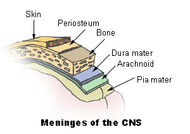(Created page with '{{BioPsy}} {{Infobox Anatomy | Name = Periosteum | Latin = | GraySubject = | GrayPage = | Image = Bone growth.png | Caption = compact …') |
|||
| Line 36: | Line 36: | ||
{{Bone and cartilage}} |
{{Bone and cartilage}} |
||
| + | [[Category:Biology of proprioception]] |
||
[[Category:Skeletal system]] |
[[Category:Skeletal system]] |
||
Latest revision as of 15:45, 30 March 2010
Assessment |
Biopsychology |
Comparative |
Cognitive |
Developmental |
Language |
Individual differences |
Personality |
Philosophy |
Social |
Methods |
Statistics |
Clinical |
Educational |
Industrial |
Professional items |
World psychology |
Biological: Behavioural genetics · Evolutionary psychology · Neuroanatomy · Neurochemistry · Neuroendocrinology · Neuroscience · Psychoneuroimmunology · Physiological Psychology · Psychopharmacology (Index, Outline)
| Periosteum | ||
|---|---|---|
| compact spongy bone | ||
| Latin | ' | |
| Gray's | subject # | |
| System | ||
| MeSH | [1] | |
| Meninges of the CNS | ||
Periosteum is a membrane that lines the outer surface of all bones,[1] except at the joints of long bones.[2] Endosteum lines the inner surface of all bones.
Periosteum consists of dense irregular connective tissue. Periosteum is divided into an outer "fibrous layer" and inner "cambium layer" (or "osteogenic layer"). The fibrous layer contains fibroblasts, while the cambium layer contains progenitor cells that develop into osteoblasts. These osteoblasts are responsible for increasing the width of a long bone[3] and the overall size of the other bone types. After a bone fracture the progenitor cells develop into osteoblasts and chondroblasts, which are essential to the healing process.
As opposed to osseous tissue, periosteum has nociceptors nerve endings, making it very sensitive to manipulation. It also provides nourishment by providing the blood supply. Periosteum is attached to bone by strong collagenous fibers called Sharpey's fibres, which extend to the outer circumferential and interstitial lamellae. It also provides an attachment for muscles and tendons.
Periosteum that covers the outer surface of the bones of the skull is known as "pericranium".
Additional images
References
- ↑ Netter, Frank H. (1987). Musculoskeletal system: anatomy, physiology, and metabolic disorders. Summit, New Jersey: Ciba-Geigy Corporation ISBN 0914168886, p.170
- ↑ At the joints of long bones the bone's outer surface is lined with "articular cartilage", a type of hyaline cartilage.
- ↑ The length of a long bone is controlled by the epiphyseal plate.
Bibliography
- Brighton, Carl T. and Robert M. Hunt (1997), "Early histologic and ultrastructural changes in microvessels of periosteal callus", Journal of Orthopaedic Trauma, 11 (4): 244-253
Template:Bone and cartilage
| This page uses Creative Commons Licensed content from Wikipedia (view authors). |

